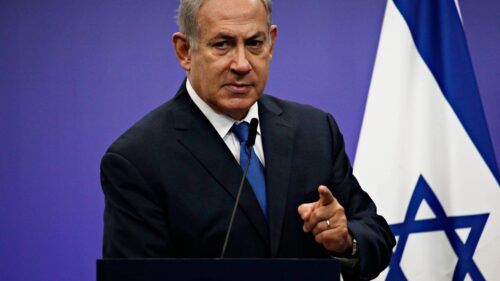Like in Europe, the years between World War I and World War II were a time of major political shifts in the Arab world. In Syria, Iraq, Egypt, and Lebanon, movements appeared that resembled fascist regimes in Europe such as the Nazis, the National Socialist German Workers’ Party, in Germany.
Yet, to date, these fascist movements in the Arab world have not been compared to fascist movements in Europe. Some were heavily influenced by Europe’s fascism. In the case of the Lebanese and Spanish Phalangism, for instance, they both strongly emphasized Catholic religious identity to push their fascist agendas.
Addressing this gap in the literature, this article explores the Lebanese “Phalanges,” known as al-Katā’ib in Arabic, a paramilitary group which presented itself as apolitical but actually concerned itself with the national interests of Lebanon.
How the Phalanges drew inspiration from European Fascism
While some researchers have focused on the Lebanese Phalanges in the past, no research has compared them to fascism in Europe. This is striking because they were inspired by the German Nazi regime, the Sokol in Czechoslovakia and, as the name implies, the Spanish Falange. Modeling them after these movements, Pierre Gemayel created the Lebanese Phalanges in 1936.
The Lebanese Phalanges shared several characteristics with European fascist movements at the time, such as upholding the importance of family and home and identifying an “other” to blame while picturing a glorious imaginary past.
Gemayel visited Berlin during the 1936 Olympic Games. He was greatly attracted to Nazism and envisaged a Lebanon that would take after the Nazi footprint:
I was the captain of the Lebanese football team and the president of the Lebanese Football Federation. We went to the Olympic Games of 1936 in Berlin. And I saw then this discipline and order. And I said to myself: “Why can’t we do the same thing in Lebanon?” So when we came back to Lebanon, we created this youth movement. When I was in Berlin then, Nazism did not have the reputation which it has now. Nazism? In every system in the world, you can find something good. But Nazism was not Nazism at all. The word came afterwards. In their system, I saw discipline. And we in the Middle East, we need discipline more than anything else.
During his trip, Gemayel also visited several other European countries. In each of these countries, he made connections with their radical youth movements, studying their structure and observing them closely.
The Lebanese Phalanges
The Lebanese “Phalanges” were founded as a Christian “democratic” political organization in the 1930s that aimed to create a Westernized militant Lebanon. The organization’s leaders were young, middle-class Christians with connections to France, which at the time ran the League of Nations Mandate for Syria and the Lebanon. In spite of the movement being officially secular, it was supported mainly by the Maronite Catholics, who often saw the Phalanges as the political expression of their Christian faith. The Maronites trace their origins to St. Maron (Arabic: Mārūn), a Syrian hermit of the late 4th and early 5th centuries.
In line with fascist ideology, the movement upholds the importance of family and home with the motto “God, country, and family.” Their flag, which is also their logo, shows the cedar tree, which is often a trademark of Lebanon and “Lebaneseness.”
It is important to point out here that the Maronites, unlike some European fascists, did not see the Phalanges as a substitute for their religion. The Phalanges connected fascist aspirations with religion.
The Lebanese Phalanges were also founded as a reaction to Muslim irredentist demands and to the growing strength of the Syrian Social Nationalist Party, which advocated for the absorption of Lebanon into a Greater Syria. The latter was a secret society that grew from a few students to about 1,000 members by 1935. In the 1930s the party expanded into Syria, Transjordan, and Palestine.
For Lebanon, this era, 1936–1946, falls within the French mandate of the country. Lebanon gained its independence in 1943, and the French left the country in 1946. Also, 1945 was the end of WWII; in that same year, the Lebanese Phalanges put members forward for election but failed to win any seats until 1958.
The Spanish connection
The founders of the Phalanges chose the name, meaning “phalanx,” because they wanted it to be a semi-military group to instill discipline and organization in the Lebanese youth. Spanish political leader José Antonio Primo de Rivera had named his party the Falange Española for similar reasons. This kind of concentration on youth was common in European fascism, particularly Nazism and Italian Fascism. Thus, most Lebanese Phalanges supporters at the time were the youth, particularly students and recent graduates. They stormed the streets of Beirut, chanting for Lebanese independence while asserting the country’s unique non-Arab identity.
Similar to their Spanish Falange, the Lebanese Phalanges adopted a nostalgic rhetoric about “the return to empire.” For these Lebanese, this meant a future where the Phoenician legacy in Lebanon would once again take its place among the world’s nations while placing Christianity at its center.
In Spain, Falangism also placed a strong emphasis on Catholic religious identity, though it held some secular views on the Church’s direct influence in society, such as believing that the state should have supreme authority over the nation.
The Spanish movement gained importance from 1936 onwards, with the outbreak of the Spanish Civil War between right-wing nationalist rebels and supporters of the left-wing Second Spanish Republic. The Falange enjoyed an enormous influx of membership from frightened and disillusioned middle-class people to anti-republican militants.
By the beginning of 1937, it had several hundred thousand affiliates. General Francisco Franco, leader of the nationalist cause, weakened the movement’s original national-syndicalist ideology and made the Falange the official state party with a nominal membership of 900,000 in a country of 25 million. They provided the largest organized political following fully committed to the regime, and Franco found them indispensable. Franco was a Spanish military general who led the nationalist forces in overthrowing the Second Spanish Republic during the Spanish Civil War and thereafter ruled over Spain from 1939 to 1975 as a dictator.
Spanish Falangism promoted the revival and development of the Spanish Empire. The Spanish Falange and its affiliates in Hispanic states across the world promoted a form of pan-Hispanism which they described with the term Hispanidad. This advocated both a cultural and economic union of Hispanic societies around the world.
In fact, the Falange even produced maps that included Portugal as a province of Spain, especially during its early years of existence. After the Spanish Civil War, some radical members of the Spanish Falange called for reunification with Portugal and the annexation of former Spanish territories in the French Pyrenees. It has sought to unite ethnically Hispanic peoples, with proposals to create a commonwealth or federation of Spanish-speaking states headed by Spain.
Similarly, the Lebanese Phalanges believe the Phoenicians were the original residents of the Mediterranean coast. The Lebanese Phalanges imagined a glorious past, combining stories of a mythical golden age with ancestral legends and national rebirth.
The Phalanges’ leaders often used Phoenician phraseology to express the non-Arab identity of Lebanon, for instance, “Lebanon is not Phoenician […] it is Phoenician, however, in culture and ethos, bequeathed to the modern Lebanese by their forefathers in ancient times.” In this way, the Phalanges saw themselves as protectors of the Lebanese nation and carriers of Western influence against Arabs.
Although more work is needed on both movements’ ideological placement, this preliminary treatment should make clear how the Phalanges of Lebanon drew from the nationalist ideologies of their European counterparts.
[Erica Beinlich edited this piece.]
The views expressed in this article are the author’s own and do not necessarily reflect Fair Observer’s editorial policy.
Support Fair Observer
We rely on your support for our independence, diversity and quality.
For more than 10 years, Fair Observer has been free, fair and independent. No billionaire owns us, no advertisers control us. We are a reader-supported nonprofit. Unlike many other publications, we keep our content free for readers regardless of where they live or whether they can afford to pay. We have no paywalls and no ads.
In the post-truth era of fake news, echo chambers and filter bubbles, we publish a plurality of perspectives from around the world. Anyone can publish with us, but everyone goes through a rigorous editorial process. So, you get fact-checked, well-reasoned content instead of noise.
We publish 3,000+ voices from 90+ countries. We also conduct education and training programs
on subjects ranging from digital media and journalism to writing and critical thinking. This
doesn’t come cheap. Servers, editors, trainers and web developers cost
money.
Please consider supporting us on a regular basis as a recurring donor or a
sustaining member.
Will you support FO’s journalism?
We rely on your support for our independence, diversity and quality.













Comment